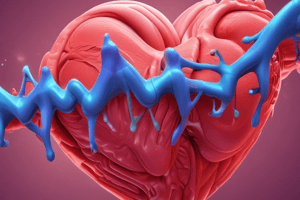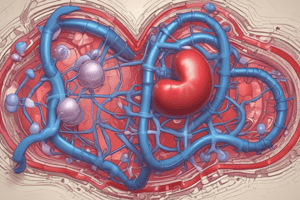Podcast
Questions and Answers
What is a primary effect of digoxin on the heart muscle?
What is a primary effect of digoxin on the heart muscle?
- Increases conduction of heart cells
- Increases myocardial contraction stroke volume (correct)
- Decreases myocardial contraction
- Increases heart rate
The antidote for digoxin toxicity is Digibind.
The antidote for digoxin toxicity is Digibind.
True (A)
What are the normal therapeutic serum digoxin levels?
What are the normal therapeutic serum digoxin levels?
0.8 to 2 ng/mL
One of the side effects of digitalis glycosides is __________.
One of the side effects of digitalis glycosides is __________.
Match the following nursing responsibilities with their correct actions:
Match the following nursing responsibilities with their correct actions:
What is one life-threatening adverse reaction associated with digoxin?
What is one life-threatening adverse reaction associated with digoxin?
Digoxin should be administered if the pulse rate is 55 beats/min.
Digoxin should be administered if the pulse rate is 55 beats/min.
What does an increase in intracellular sodium due to cardiac glycosides lead to?
What does an increase in intracellular sodium due to cardiac glycosides lead to?
What is the primary function of the sinoatrial (SA) node?
What is the primary function of the sinoatrial (SA) node?
The atrioventricular (AV) node has a resting heart rate of 60 to 80 beats per minute.
The atrioventricular (AV) node has a resting heart rate of 60 to 80 beats per minute.
What happens if the sinoatrial (SA) node fails?
What happens if the sinoatrial (SA) node fails?
In pulmonary circulation, the heart pumps deoxygenated blood from the right ventricle through the __________ to the lungs.
In pulmonary circulation, the heart pumps deoxygenated blood from the right ventricle through the __________ to the lungs.
Match the following components of the cardiovascular system with their functions:
Match the following components of the cardiovascular system with their functions:
What can result from left-sided heart failure?
What can result from left-sided heart failure?
Right-sided heart failure leads to fluid retention in the lungs.
Right-sided heart failure leads to fluid retention in the lungs.
What is the heart's function in systemic circulation?
What is the heart's function in systemic circulation?
Flashcards
SA Node
SA Node
The sinoatrial node, often called the pacemaker, controls heartbeat, usually at 60-80 beats per minute in adults.
AV Node
AV Node
The atrioventricular node, located in the heart, can take over if the SA node fails. It controls heart rate at a slower pace of 40-60 beats per minute.
Left-sided Heart Failure
Left-sided Heart Failure
The left ventricle struggles to pump blood out the aorta, leading to blood backing up in the lungs.
Right-sided Heart Failure
Right-sided Heart Failure
Signup and view all the flashcards
Pulmonary Circulation
Pulmonary Circulation
Signup and view all the flashcards
Systemic Circulation
Systemic Circulation
Signup and view all the flashcards
Cardiac Impulse
Cardiac Impulse
Signup and view all the flashcards
Conduction of Electrical Impulses
Conduction of Electrical Impulses
Signup and view all the flashcards
Digitalis Glycosides
Digitalis Glycosides
Signup and view all the flashcards
Positive Inotropic Effect
Positive Inotropic Effect
Signup and view all the flashcards
Negative Chronotropic Effect
Negative Chronotropic Effect
Signup and view all the flashcards
Negative Dromotropic Effect
Negative Dromotropic Effect
Signup and view all the flashcards
Digoxin (Lanoxin)
Digoxin (Lanoxin)
Signup and view all the flashcards
Digitalis Toxicity
Digitalis Toxicity
Signup and view all the flashcards
Digoxin Immune Fab (Digibind)
Digoxin Immune Fab (Digibind)
Signup and view all the flashcards
Serum Digoxin Level (Therapeutic Range)
Serum Digoxin Level (Therapeutic Range)
Signup and view all the flashcards
Study Notes
Cardiac Drugs
- Cardio Vascular System is the topic of study.
- Cardiac glycosides, antianginals, and antidysrhythmic drugs
- Diuretic drugs
- Antihypertensives
- Anticoagulants, antiplatelet, and thrombolytics
- Antihyperlipidemic and peripheral vasodilator drugs are all part of the cardiovascular system.
Cardiac Conduction System
- Sinoatrial (SA) node: often called the pacemaker, regulates heartbeat at 60-80 beats/min in normal adults.
- Atrioventricular (AV) node: located on the posterior right side of the interatrial septum; the AV node has a rate of 40-60 beats/min.
- If the SA node fails, the AV node takes over to regulate heart rate.
- Ventricles can contract independently at 30 - 40 times per minute.
Regulation of Heart Rate and Blood Flow
- Cardiac output: volume of blood pumped from each ventricle per minute
- Cardiac Output = Stroke Volume x Heart Rate
Cardiac Output
- Preload: the diastolic filling with venous blood
- Contractility: the systolic ejection
- Afterload: resistance to systolic ejection. Hypertension and valvular stenosis affect afterload
- Cardiac output is the product of stroke volume and heart rate
Circulation
- Pulmonary circulation: The heart pumps deoxygenated blood to the lungs via the pulmonary artery. Oxygenated blood returns to the left atrium via pulmonary veins
- Systemic circulation: Blood is propelled from the left ventricle through the aorta and into the general circulation. Arteries and arterioles deliver blood to capillary beds. Capillaries exchange nutrition in exchange for waste products, and blood returns to the heart via venules and veins.
Heart Failure
- Left-sided: Left ventricle does not pump blood adequately from lungs and left atrium into the peripheral circulation, causing fluid backup into lung tissue.
- Right-sided: Heart does not pump blood returned into the right atrium from systemic circulation. Back-up of blood leads to peripheral edema. Left-sided heart failure can cause right-sided heart failure and vice versa.
Non-Pharmacological Measures: Heart Failure
- Limit salt intake to 2g/day (approximately 1 teaspoon).
- Decrease or avoid alcohol consumption. Excessive alcohol intake can cause cardiomyopathy.
- Fluid intake may be restricted.
- Smoking should be avoided.
- Mild exercise, like walking or cycling
- Cardiac drugs for the prevention of Heart attack.
Cardiac Glycosides
- A group of drugs that inhibit the sodium-potassium pump. This increase leads to an influx of calcium, causing cardiac muscle fibers to contract more effectively.
- Digitalis glycosides: have positive inotropic, negative chronotropic, and negative dromotropic actions.
Rapid-acting Digitalis: Digoxin (Lanoxin)
- Indication: Treatment of heart failure and atrial fibrillation
- Side effects: anorexia, nausea, vomiting, diarrhea, abdominal pain, headache, blurred vision (yellow-green halos), diplopia, photophobia, drowsiness, dizziness, fatigue, confusion.
- Adverse Reactions: bradycardia, and visual disturbances
- Life-threatening: AV block, cardiac dysrhythmias
- Digoxin immune Fab (Digibind) is an antidote for digitalis toxicity. Administered IV—760–800 mg diluted in 50 mL of NSS
- Nursing Responsibilities: Ascertain apical pulse; if less than 60 bpm - do not administer. Monitor for signs of peripheral/pulmonary edema, serum digoxin levels (0.8-2 ng/mL), serum potassium level (3.5-5.3 mEq/L)
Other Agents used to Treat Heart Failure
- Vasodilators promote venous blood return to the heart; reduces preload, and oxygen demand on the heart.
- Angiotensin-converting enzyme (ACE) inhibitors decrease blood volume by dilating venules and arterioles; moderately reduce aldosterone release.
- Diuretics are first-line drug treatment for reducing fluid volume; often prescribed with digoxin or other agents.
- Nesiritide (Natrecor): atrial natriuretic peptide hormone; inhibits antidiuretic hormone (ADH) increasing urine sodium loss
Antianginal Drugs
-
Used to treat angina pectoris (acute, chest-related pain due to decreased myocardial blood flow).
-
Nitrates (short-acting): nitroglycerin (Nitrostat, Nitro-Bid, Transderm-Nitro), route (PO/SL/IV/Topical). Dosages- PO/SL: 0.3, 0.4, 0.6mg; IV: 5 mcg/min initially, Ointment: 2%, Patch: 2.5–15 mg/day.
-
Side Effects: Nausea, headache, blurred vision, dizziness, syncope, weakness, diaphoresis, flushing, confusion, pallor, rash, dry mouth, palpitations, tolerance.
-
Adverse Reactions: Hypotension, reflex tachycardia
-
Nitrates (long-acting): isosorbide mononitrate (Imdur), Route: PO. Dosage: 5–20 mg BID (maximum: 40 mg/day). Indication: To prevent anginal attacks.
-
Side effects: headache, flushing, hypotension.
Antidysrhythmic Drugs
- Cardiac dysrhythmia (arrhythmia): deviation from normal heart rate or pattern (bradycardia, tachycardia, or irregular).
Classes, Actions, and Indications of Antidysrhythmic Drugs
- Class I: sodium channel blockers
- Class II: beta blockers
- Class III: prolong repolarization
- Class IV: calcium channel blockers
Antihyperlipidemic
- Drugs that lower Lipid levels
- Bile acid sequestrants
- Fibrates
- Nicotinic acid
- HMG-CoA reductase inhibitors (statins)
- Ezetimibe
Other Agents to treat Angina Pectoris
- Beta adrenergic blockers such as metoprolol reduce cardiac oxygen, which decreases heart rate and contractility.
- Calcium channel blockers like amlodipine, diltiazem, nicardipine, and verapamil are used for angina pectoris, hypertension and dysrhythmias
Diuretics
- To decrease hypertension
- To decrease edema (peripheral and pulmonary) in heart failure (HF) and renal or liver disorders.
- Thiazides and thiazide-like diuretics
- Act on distal convoluted renal tubule
- Not effective for immediate diuresis in severe renal dysfunction.
- Hydrochlorothiazide (Esidrix, HCTZ)
- Route: PO
- Adult dosages (hypertension): 12.5-50 mg/day
- Adult dosages (edema): 25-100 mg/day
- Indications: to increase urine output; to treat hypertension; edema from HF, hepatic cirrhosis, renal dysfunction
- Loop (high-ceiling) diuretics
- Act on the thick ascending loop of Henle
- Often called high-ceiling or potassium-wasting diuretics.
- Furosemide (Lasix)
- Indicated for fluid retention, fluid overload, renal dysfunction, cirrhosis, or hypertension.
- Contraindicated when patient has severe hypovolemia, anuria, or hepatic coma.
Nursing Responsibilities
- Monitor vital signs, serum electrolytes, glucose, uric acid, and cholesterol levels.
- Observe for signs and symptoms of hypokalemia (e.g., muscle weakness and leg cramps).
- Also, patients weight, fluid levels, and observe for other abnormalities.
Studying That Suits You
Use AI to generate personalized quizzes and flashcards to suit your learning preferences.




